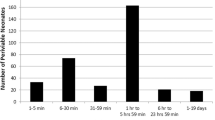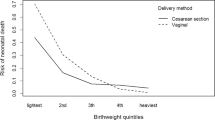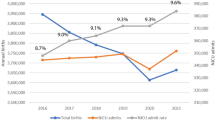Abstract
Objective:
To determine the contribution of infants born at the threshold of viability (defined as <750 g birth weight) and the role of regionalization of perinatal care on the neonatal mortality rate (NMR) in Colorado.
Study Design:
We performed a retrospective cohort study, evaluating all live births in Colorado from 1991 to 2003, and comparing the periods 1991 to 1996 versus 1997 to 2003.
Result:
The overall unadjusted NMR of the two time periods was 4.3 and 4.4 per 1000 live births, respectively (P=0.42). The contribution of infants with birth weights <750 g to the overall NMR increased from 45.0 to 54.5% (P<0.01). The odds of death for infants <750 g increased between time periods (Odd ratio 1.3, 95% Confidence interval 1.11, 1.61). However, NMR decreased between time periods for all birth weight categories, until infants <600 g. With respect to regionalization, the number of infants <750 g born in a level III care center increased slightly between the two time periods (69.6 versus 73.3%; P=0.04); however, adjusted analysis showed no difference in the practice of regionalization between time periods. Regardless of time period, infants who weighed <750 g born in a level III center had 60% lower mortality risk when compared to <750 g infants born in a non-level III center (P<0.01; 95% CI 0.30, 0.52).
Conclusion:
Despite advances in neonatal medicine, the overall NMR in the state of Colorado remained unchanged between the time periods of 1991 to 1996 and 1997 to 2003. Infants at the threshold of viability continue to have a large impact on the Colorado NMR, making up a larger proportion of overall neonatal deaths. While the results demonstrate that the risk of mortality is significantly reduced for <750 g infants born in a level III center, the practice of regionalization has not changed between the two time periods. Improved efforts to standardize the referral practices to ensure delivery of <750 g infants in level III centers could potentially reduce the impact of these infants on the NMR. While the overall NMR in Colorado has not changed between the two time periods, the NMR for infants >600 g has significantly decreased, suggesting that the boundary delineating the threshold of viability needs reevaluation, as it may have been pushed lower than previously defined.
This is a preview of subscription content, access via your institution
Access options
Subscribe to this journal
Receive 12 print issues and online access
$259.00 per year
only $21.58 per issue
Buy this article
- Purchase on Springer Link
- Instant access to full article PDF
Prices may be subject to local taxes which are calculated during checkout

Similar content being viewed by others
References
Colorado Department of Public Health Environment. Colorado Vital Statistics 1999 May. 2001, http://www.ext.colostate.edu/cis/health-ch1.pdf.
Schwartz RM, Luby AM, Scanlon JW, Kellogg RJ . Effect of surfactant on morbidity, mortality, and resource use in newborn infants weighing 500–1500 g. New Engl J Med 1994; 330 (21): 1476–1480.
Lucey JF, Rowan CA, Shiono P, Wilkinson AR, Kilpatrick S, Payne NR et al. Fetal infants: the fate of 4172 infants with birth weights of 401–500 grams—the Vermont Oxford Network Experience (1996–2000). Pediatrics 2004; 113 (6): 1559–1566.
Lemons JA, Bauer CR, Oh W, Korones SB, Papile L, Stoll BJ et al. Very low birth weight outcomes of the National Institute of Child Health and Human Development Neonatal Research Network, January 1995 through December 1996. Pediatrics 2001; 107: 1–8.
Hernández JA, Hall DM, Goldson EJ, Chase M, Garrett C . Impact of infants born at the threshold of viability on the neonatal mortality rate in Colorado. J Perinatol 2000; 1: 21–26.
Bowes WA . A review of the perinatal mortality in Colorado, 1971–1978, and its relationship to the regionalization of perinatal services. Am J Obstet Gynecol 1981; 141 (8): 1045–1052.
Bode MM, O'Shea TM, Metzguer KR, Stiles AD . Perinatal regionalization and neonatal mortality in North Carolina, 1968–1994. Am J Obstet Gynecol 2001; 184 (6): 1302–1307.
Clement MS . Perinatal care in Arizona 1950–2002: a study of the positive impact of technology, regionalization and the Arizona Perinatal Trust. J Perinatol 2005; 25: 503–508.
Yeast JD, Poskin M, Stockbauer JW, Shaffer S . Changing patterns in regionalization of perinatal care and the impact on neonatal mortality. Am J Obstet Gynecol 1998; 178: 131–135.
Hein HA . Regionalized perinatal care in North America. Semin Neonatol 2004; 9: 111–116.
American Academy of Pediatrics Committee on the Fetus Newborn. Levels of neonatal care. Pediatrics 2004; 114 (5): 1341–1347.
Colorado Department of Public Health and Environment. Colorado Vital Statistics 1996. Vital Statistics Section: Denver, CO, 1997; 239–246.
American Academy of Pediatrics Committee on Fetus and Newborn. Perinatal care at the threshold of viability. Pediatrics 1995; 96: 974–976.
Hintz SR, Poole WK, Wright LL, Fanaroff AA, Kendrick DE, Laptook AR et al. Changes in mortality and morbidities among infants born at less than 25 weeks during the post-surfactant era. Arch Dis Child Fetal Neonatal Ed 2005; 90: F128–F133.
March of Dimes. http://search.marchofdimes.com/peristats/.
Shankaran S, Fanaroff AA, Wright LL, Stevenson DK, Donovan EF, Ehrenkranz RA et al. Risk factors for early death among extremely low birth weight infants. Am J Obstet Gynecol 2002; 186: 796–802.
Hack M, Fanaroff AA . Outcomes of extremely low birthweight and gestational age in the 1990's. Early Hum Dev 1999; 53: 193–218.
Ho S, Saigal S . Current survival and early outcomes of infants of borderline viability. NeoReviews 2005; 6 (3): e123–e131.
Dooley SL, Freels SA, Turnock BJ . Quality assessment of perinatal regionalization by multivariate analysis: Illinois, 1991–1993. Obstet Gynecol 1997; 89 (2): 193–198.
Allen MC, Donohue PK, Dusman AE . The limit of viability—Neonatal outcome of infants born at 22–25 weeks gestation. N Engl J Med 1993; 329 (22): 1597–1601.
MacDonald H, the American Academy of Pediatrics Committee on the Fetus and Newborn. Perinatal care at the threshold of viability. Pediatrics 2002; 110 (5): 1024–1027.
Acknowledgements
We thank Dr Dennis Lezotte, Dr Ned Calonge and Dr Jill Norris for their assistance in study design and development of this work. We also thank Dr Meica Efird, Dr Gerald Merenstein and Dr Daniel Hall for their insightful comments and suggestions. We have no financial support to disclose.
Author information
Authors and Affiliations
Corresponding author
Rights and permissions
About this article
Cite this article
Kamath, B., Box, T., Simpson, M. et al. Infants born at the threshold of viability in relation to neonatal mortality: Colorado, 1991 to 2003. J Perinatol 28, 354–360 (2008). https://doi.org/10.1038/sj.jp.7211918
Received:
Accepted:
Published:
Issue Date:
DOI: https://doi.org/10.1038/sj.jp.7211918
Keywords
This article is cited by
-
The Mortality of Periviable and Extremely Premature Infants and Their Impact on the Overall Neonatal Mortality Rate
Scientific Reports (2020)
-
Impact of neonatologist availability on preterm survival without morbidities
Journal of Perinatology (2018)
-
Factors influencing the care provided for periviable babies in Australia: a narrative review
Reproductive Health (2015)
-
Periviable birth: executive summary of a Joint Workshop by the Eunice Kennedy Shriver National Institute of Child Health and Human Development, Society for Maternal-Fetal Medicine, American Academy of Pediatrics, and American College of Obstetricians and Gynecologists
Journal of Perinatology (2014)
-
Reducing neonatal mortality in developing countries: low-cost interventions are the key determinants
Journal of Perinatology (2009)



